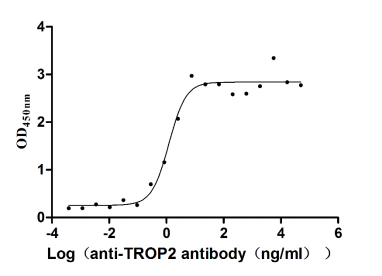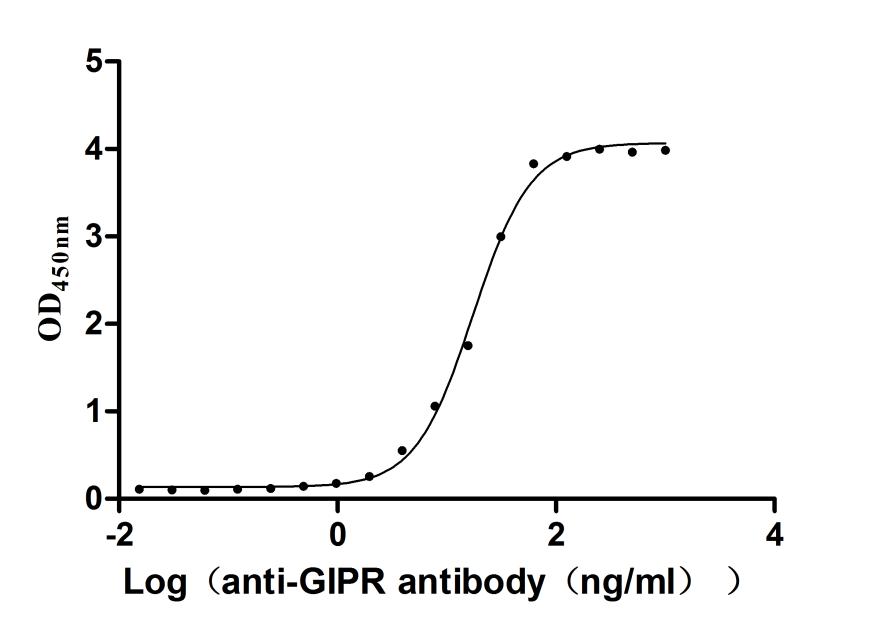Recombinant Rat Transient receptor potential cation channel subfamily M member 8 (Trpm8), partial
-
中文名稱:大鼠Trpm8重組蛋白
-
貨號:CSB-YP823179RA
-
規(guī)格:
-
來源:Yeast
-
其他:
-
中文名稱:大鼠Trpm8重組蛋白
-
貨號:CSB-EP823179RA
-
規(guī)格:
-
來源:E.coli
-
其他:
-
中文名稱:大鼠Trpm8重組蛋白
-
貨號:CSB-EP823179RA-B
-
規(guī)格:
-
來源:E.coli
-
共軛:Avi-tag Biotinylated
E. coli biotin ligase (BirA) is highly specific in covalently attaching biotin to the 15 amino acid AviTag peptide. This recombinant protein was biotinylated in vivo by AviTag-BirA technology, which method is BriA catalyzes amide linkage between the biotin and the specific lysine of the AviTag.
-
其他:
-
中文名稱:大鼠Trpm8重組蛋白
-
貨號:CSB-BP823179RA
-
規(guī)格:
-
來源:Baculovirus
-
其他:
-
中文名稱:大鼠Trpm8重組蛋白
-
貨號:CSB-MP823179RA
-
規(guī)格:
-
來源:Mammalian cell
-
其他:
產(chǎn)品詳情
-
純度:>85% (SDS-PAGE)
-
基因名:
-
Uniprot No.:
-
別名:Trpm8; Cmr1; Transient receptor potential cation channel subfamily M member 8; Cold menthol receptor 1
-
種屬:Rattus norvegicus (Rat)
-
蛋白長度:Partial
-
蛋白標(biāo)簽:Tag?type?will?be?determined?during?the?manufacturing?process.
The tag type will be determined during production process. If you have specified tag type, please tell us and we will develop the specified tag preferentially. -
產(chǎn)品提供形式:Lyophilized powder
Note: We will preferentially ship the format that we have in stock, however, if you have any special requirement for the format, please remark your requirement when placing the order, we will prepare according to your demand. -
復(fù)溶:We recommend that this vial be briefly centrifuged prior to opening to bring the contents to the bottom. Please reconstitute protein in deionized sterile water to a concentration of 0.1-1.0 mg/mL.We recommend to add 5-50% of glycerol (final concentration) and aliquot for long-term storage at -20℃/-80℃. Our default final concentration of glycerol is 50%. Customers could use it as reference.
-
儲存條件:Store at -20°C/-80°C upon receipt, aliquoting is necessary for mutiple use. Avoid repeated freeze-thaw cycles.
-
保質(zhì)期:The shelf life is related to many factors, storage state, buffer ingredients, storage temperature and the stability of the protein itself.
Generally, the shelf life of liquid form is 6 months at -20°C/-80°C. The shelf life of lyophilized form is 12 months at -20°C/-80°C. -
貨期:Delivery time may differ from different purchasing way or location, please kindly consult your local distributors for specific delivery time.Note: All of our proteins are default shipped with normal blue ice packs, if you request to ship with dry ice, please communicate with us in advance and extra fees will be charged.
-
注意事項:Repeated freezing and thawing is not recommended. Store working aliquots at 4°C for up to one week.
-
Datasheet :Please contact us to get it.
靶點詳情
-
功能:Receptor-activated non-selective cation channel involved in detection of sensations such as coolness, by being activated by cold temperature below 25 degrees Celsius. Activated by icilin, eucalyptol, menthol, cold and modulation of intracellular pH. Involved in menthol sensation. Permeable for monovalent cations sodium, potassium, and cesium and divalent cation calcium. Temperature sensing is tightly linked to voltage-dependent gating. Activated upon depolarization, changes in temperature resulting in graded shifts of its voltage-dependent activation curves. The chemical agonists menthol functions as a gating modifier, shifting activation curves towards physiological membrane potentials. Temperature sensitivity arises from a tenfold difference in the activation energies associated with voltage-dependent opening and closing.
-
基因功能參考文獻:
- Results demonstrate that GFRalpha3 knockdown specially inhibits cold hyperalgesia following CCI via decreasing the expression level and plasma membrane trafficking of TRPM8 in DRG. GFRalpha3 and its downstream mediator, TRPM8, represent a new analgesia axis which can be further exploited in sensitized cold reflex under the condition of chronic pain. PMID: 28867384
- It is associated with sensitivity to cold sensation and is overexpressed in the skin of ovariectomized mammals. PMID: 28626113
- Our findings show, for the first time, that the activation of TRPM8 and TRPA1 inhibits ASMC proliferative phenotype. PMID: 27236325
- find that as with TRPV1, activation of TRPM8 channels can be used as a means to target intracellular uptake of cell-impermeable sodium channel blockers PMID: 28038937
- Praziquantel is a relatively potent and selective partial agonist of the mammalian and avian cold and menthol receptor TRPM8. PMID: 29054683
- Pretreatment with perineural resiniferatoxin inhibits the development of spinal nerve ligation-induced mechanical, heat, and cold hypersensitivity. The antinociceptive effect of perineural resiniferatoxin against cold stimuli seems to be related to the TRPM8 expression in the DRG. PMID: 27329106
- TRPM8 activation attenuates Ang II-induced activation of RhoA-Rock2 and JAK2 signaling pathways in vascular smooth muscle cells (VSMCs). Ang II reduces TRPM8 expression in a dose- and time-dependent manner in VSMCs and is involved in hypertension. PMID: 28138709
- Activation of TRPM8 ion channel increases the level of pro-inflammatory cytokines in normotensive Wistar rats. Hypertension eliminates the effect of TRPM8 activation on pro-inflammatory cytokines. PMID: 27712653
- Data indicates that TRPM8 is closely associated with visceral pain stimulation, and could be an independent prognostic biomarker for diabetes. PMID: 27051022
- The findings suggest that activation of meningeal transient receptor potential channel M8 may contribute to the pain of migraine. PMID: 25944818
- Report essential role of skin TRPM8 in a model of acute cold-induced urinary urgency. PMID: 25843641
- Retrograde tracing method indicated that TRPM8-IR nerve fibers in the gingiva and incisive papilla originate from small sensory neurons in the trigeminal ganglion. PMID: 25978347
- Which can be suppressed by menthol acting via TRPM8. PMID: 25539933
- TRPM8 may be involved in migraine mechanism probably by activation of the NMDAR pathway. PMID: 26014706
- Data indicate that voltage is a partial activator of transient receptor potential melastatin 8 (TRPM8). PMID: 25352597
- The region adjacent to the C-end of the inner gate in TRPM8 channels plays a central role in allosteric channel activation. PMID: 25157108
- The results suggest that TRPM8 channels in rat odontoblasts play a role in detecting low-temperature stimulation of the dentin surface PMID: 24358160
- The data presented here support a contribution of TRPM8 to the pathophysiology of cold hypersensitivity. PMID: 24472724
- TRPM8 channels are probably a component of the detrusor overactivity pathway activated by sudden body cooling. PMID: 23001687
- TRPM8 can respond to cold stimulation when food and drinks pass through oral and pharyngeal cavities. PMID: 23132652
- Membrane and action potential properties of TRPM8-expressing dorsal root ganglion neurons at 24 degrees C and 10 degrees C, were characterized. PMID: 23092296
- TRPM8 channels play a role in body temperature regulation. PMID: 22571355
- Thermosensitive TRP ion channels of hypothalamus may be involved in the mechanisms of thermal adaptation at the level of gene expression. PMID: 23293814
- TRPM8 may play different roles in mechanical allodynia, cold and thermal hyperalgesia that develop after nerve injury. PMID: 22111979
- TRPM8 and AR were expressed generally in urogenital tract of male rats. PMID: 21947852
- Neuronal input through TRPM8-positive bladder afferent neurons is augmented after bladder outlet obstruction(BOO). However, the neurochemical phenotype of the up-regulated TRPM8-positive bladder afferent neurons is not changed after BOO. PMID: 21684817
- no role in mast cell activation PMID: 21906810
- TRPM8-expressing sensory neurons with dichotomizing axons projecting to the skin and bladder may be responsible for the urinary urgency evoked by cold sensation. PMID: 21150802
- Effect of TRPM8 ion channel activation on thermoregulatory response to cooling PMID: 21598682
- TRPM8 is expressed in the basophilic leukemia mast cell line, RBL-2H3, and that exposure to menthol or low temperatures induced Ca(2+) influx in RBL-2H3 cells, which was reversed by a TRPM8 blocker. PMID: 20934218
- TRPM8 activated by cold exhibits steep temperature dependence, and the channel openings are accompanied by large changes in entropy and enthalpy, suggesting a substantial conformation change. PMID: 20844147
- the subunit stoichiometry of the TRPM8 channel using atomic force microscopy was determined. PMID: 20214891
- alterations in the expression of TRPM8 and TRPA1 are unlikely to contribute directly to the pathogenesis of cold allodynia in a neuropathic pain model PMID: 19812688
- Our results suggest that the TRPM8-expressing bladder afferents should be classified as Adelta-fibers and C-fibers, while some of these afferents may be involved in nociceptive sensations. PMID: 19622375
- CMR1 is a member of the TRP family of excitatory ion channels and is proposed to function as a transducer of cold stimuli in the somatosensory system PMID: 11882888
- TRPM8 is preferentially expressed within a subset of rapidly responsive, low-threshold (approximately 30 degrees C), cold-sensitive neurons in trigeminal ganglia. PMID: 12634279
- TRPM8 protein is present in sensory lingual nerve fibers mainly projected from TG and might work as cold and l-menthol receptors on tongue. PMID: 15893591
- In dorsal root ganglia, TRPM8 mRNA was not expressed in the TRPV1-expressing neuronal population. Both A-fiber and C-fiber neurons expressed TRPM8. All TRPM8-expressing neurons also expressed TrkA. PMID: 16304633
- Phosphorylated-extracellular signal-regulated protein kinase-positive neurons express TRPM8 mRNA after noxious cold stimulation. PMID: 16675144
- The TRPM8 mRNA in the geniculate ganglion(CG)neurons was faintly detected at its proper position. PMID: 16831854
- TRPM8 cytoplasmic carboxyl-terminal domain contains a coiled coil that is necessary for channel assembly and sufficient for tetramer formation. PMID: 16846855
- TRPM8 and its central downstream mediators, as elements of endogenous-cooling-induced analgesia, represent a novel analgesic axis that can be exploited in chronic sensitized pain states. PMID: 16920620
- modulation of TRPM8 activity by different chemical agents unveils an important flexibility in the temperature-response curve of TRPM8 channels and cold thermoreceptors PMID: 17317754
- A chimera in which the proximal part of the C-terminal of Trpv1 replaces an equivalent section of Trpm8 C-terminal is activated by PIP2 and confers the phenotype of heat activation. PMID: 17548815
- analysis of deletion mutant oligomerization shows that the transmembrane domain is sufficient for TPRM8 assembly into tetramers. TRPM8 channels with C-terminal deletions tetramerize and localize properly but are inactive PMID: 17908685
- We studied how TRPM8 is involved in cold allodynia using rats with chronic constrictive nerve injury (CCI), a neuropathic pain model manifesting cold allodynia in hindlimbs. PMID: 18077679
- a subpopulation of airway vagal afferent nerves express TRPM8 receptors and activation of TRPM8 receptors by cold excites these airway autonomic nerves. PMID: 18534015
- TRPM8 channel blocker can act on the bladder afferent pathway to attenuate the bladder micturition reflex and nociceptive reflex responses. PMID: 18562636
- TRPM8 channels in primary urothelial cell cultures induce ionic currents and changes in intracellular calcium. PMID: 19158342
- TRPM8 channels are present in rat artery vascular smooth muscle and on activation cause vasoconstriction or vasodilatation, dependent on previous vasomotor tone PMID: 19363131
顯示更多
收起更多
-
亞細胞定位:Cell membrane; Multi-pass membrane protein. Membrane raft.
-
蛋白家族:Transient receptor (TC 1.A.4) family, LTrpC subfamily, TRPM8 sub-subfamily
-
組織特異性:Expressed in dorsal root and trigeminal ganglia. Specifically expressed in a subset of sensory neurons, including cold-sensitive neurons in trigeminal neurons.
-
數(shù)據(jù)庫鏈接:
Most popular with customers
-
Recombinant Human T-cell antigen CD7 (CD7), partial (Active)
Express system: Mammalian cell
Species: Homo sapiens (Human)
-
Recombinant Human HLA class II histocompatibility antigen gamma chain (CD74), partial (Active)
Express system: Mammalian cell
Species: Homo sapiens (Human)
-
Recombinant Human Tumor-associated calcium signal transducer 2 (TACSTD2), partial (Active)
Express system: Mammalian cell
Species: Homo sapiens (Human)
-
Recombinant Human Gastric inhibitory polypeptide receptor(GIPR),partial (Active)
Express system: Mammalian cell
Species: Homo sapiens (Human)



-AC1.jpg)











